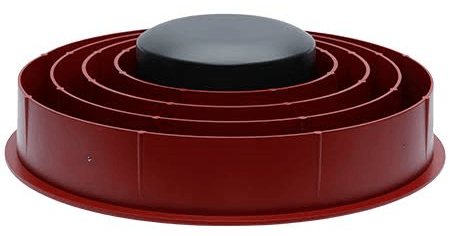An omnidirectional antenna used for GNSS applications is a choke ring antenna. A primary antenna piece sits at the center of the device, and several concentric conductive rings surround it.
These antennas are renowned for their capacity to block multipath signals, which are satellite signals that are reflected off of surrounding objects.
This comprises signals reflected from the terrain, vegetation, buildings, ground and water surfaces, and other sources. Choke ring antennas contain specifically created filters put in each groove that, when used with the same antenna arrangement, minimize multipath signals in both the L1 and L2 bands.
This makes it well suited for GPS applications in surveying and geological measurement as the path a signal travels from a transmitter to a receiver can be utilized to estimate the distance between the two (forestry applications).
GPS records can be much more accurate when multipath is reduced, especially in settings where signal attenuation is challenging. Therefore, when choke ring antennas are coupled with mapping-grade GPS receivers, centimeter-level precision might possibly be reached.
Construction
Choke ring antennas are typically made from a single aluminum billet and are composed of three to five equal-depth concentric rings arranged around a center ring that houses the antenna receiver.
In order to generate a high impedance surface that hinders surface wave propagation near the antenna and the activation of unwanted modes, choke rings are typically one-quarter wavelength deep.
Overall, a well-regulated pattern with little sensitivity to multipath is produced. The complete choke ring typically measures between 300 and 450 mm in diameter, and 60 mm in depth, and weighs around 7 kg. These dimensions make field measurement studies cumbersome, which restricts their use in forestry.
Choke rings work to absorb the electromagnetic radiation reflected off the surface of the Earth. Although the vertical configuration of the rings can vary from flat to conical, the latter is employed to help improve signal quality from low elevations. The form of a choke ring is fairly typical.
When used for outdoor applications, this antenna is frequently covered with a protective cover because of the manner it is made.
Limitations
The standard choke ring design has the intrinsic drawback of having less antenna gain at low elevation angles (below 20°). Poor positioning accuracy follows a loss in signal intensity caused by the lower antenna gain.
Benefits
Choke ring antennas excel at rejecting multipath signals coming from a source. It is well suited for GPS and radar applications because the route a signal travels from a transmitter to a receiver may be utilized to calculate the separation between the two.
A choke ring antenna in a GPS ground-based receiver can produce millimeter-accurate readings for use in surveying and geological studies.
Design of a Novel Dual-Band Circularly Polarized Choke Ring Center-Fed Antenna
This study introduces a brand-new choke ring center-fed antenna design. The proposed antenna has a folded ground plane, two layers of horizontal coaxial corrugated grooves, and two levels of longitudinal radial corrugated grooves in addition to two layers of microstrip patches.
The antenna significantly reduces the back lobe and enhances the backward ratio of the antenna as compared to the current antenna, which solely uses the choke ring construction in the horizontal direction.
The reflection coefficients for the two frequency bands, GPS L2 (1.195 ghz–1.248 ghz) and GPS L1 (1.552 ghz–1.599 ghz), according to simulation findings, are less than -10 db. The antenna’s forward-to-backward ratio exceeds 30 db across the full operational bandwidth.

